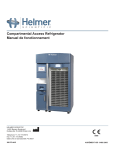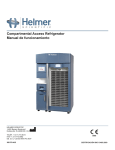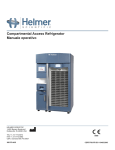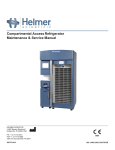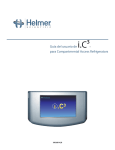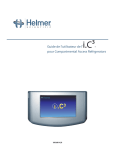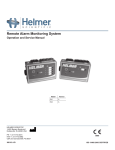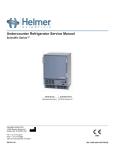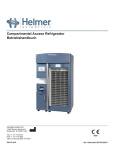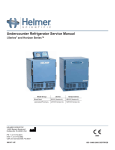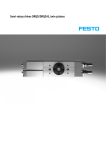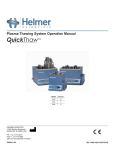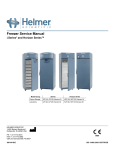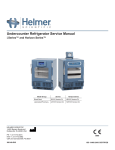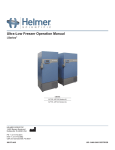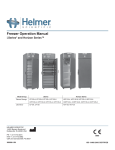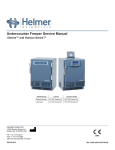Download Compartmental Access Refrigerator Operation Manual
Transcript
Compartmental Access Refrigerator Operation Manual HELMER SCIENTIFIC 14400 Bergen Boulevard Noblesville, IN 46060 USA PH +1.317.773.9073 FAX +1.317.773.9082 USA and Canada 800.743.5637 360178-A/B 0086 ISO 13485:2003 CERTIFIED Document History Revision Date CO Supersession Revision Description A 26 JAN 2015 10292 n/a Initial release. B 9 FEB 2015 10363 A Revised product labeling per regulatory requirements. * Date submitted for Change Order review. Actual release date may vary. Notes and Disclaimers Confidential / Proprietary Notices Use of any portion(s) of this document to copy, translate, disassemble or decompile, or create or attempt to create by reverse engineering or otherwise the information from Helmer Scientific products is expressly prohibited. Disclaimer This manual is intended as a guide to provide the operator with necessary instructions on the proper use and maintenance of certain Helmer Scientific products. Any failure to follow the instructions as described could result in impaired product function, injury to the operator or others, or void applicable product warranties. Helmer Scientific accepts no responsibility for liability resulting from improper use or maintenance of its products. The screenshots and component images appearing in this guide are provided for illustrative purposes only, and may vary slightly from the actual software screens and/or product components. Document Updates The document is furnished for information use only, is subject to change without notice and should not be construed as a commitment by Helmer Scientific. Helmer Scientific assumes no responsibility or liability for any errors or inaccuracies that may appear in the informational content contained in this material. For the purpose of clarity, Helmer Scientific considers only the most recent revision of this document to be valid. 360178-A/B i Contents Notes and Disclaimers . . . . . . . . . . . . . . . . . . . . . . . . . . . . . . . . . . . . . . . . . . . . . . . i Section I: General Information. . . . . . . . . . . . . . . . . . . . . . . . . . . . . . . . . . . . . . . . . 4 1 About this Manual . . . . . . . . . . . . . . . . . . . . . . . . . . . . . . . . . . . . . . . . . . . . . . . . . . . . . . . . . . . 4 1.1 1.2 1.3 Intended Audience. . . . . . . . . . . . . . . . . . . . . . . . . . . . . . . . . . . . . . . . . . . . . . . . . . . . . . . . . . . . . . . . . . . . . . 4 Model References. . . . . . . . . . . . . . . . . . . . . . . . . . . . . . . . . . . . . . . . . . . . . . . . . . . . . . . . . . . . . . . . . . . . . . 4 Copyright and Trademark. . . . . . . . . . . . . . . . . . . . . . . . . . . . . . . . . . . . . . . . . . . . . . . . . . . . . . . . . . . . . . . . 4 2 Safety Precautions. . . . . . . . . . . . . . . . . . . . . . . . . . . . . . . . . . . . . . . . . . . . . . . . . . . . . . . . . . . 4 2.1 2.2 2.3 Safety Definitions . . . . . . . . . . . . . . . . . . . . . . . . . . . . . . . . . . . . . . . . . . . . . . . . . . . . . . . . . . . . . . . . . . . . . . 4 Product Labels . . . . . . . . . . . . . . . . . . . . . . . . . . . . . . . . . . . . . . . . . . . . . . . . . . . . . . . . . . . . . . . . . . . . . . . . 5 Avoiding Injury. . . . . . . . . . . . . . . . . . . . . . . . . . . . . . . . . . . . . . . . . . . . . . . . . . . . . . . . . . . . . . . . . . . . . . . . . 5 3 General Recommendations. . . . . . . . . . . . . . . . . . . . . . . . . . . . . . . . . . . . . . . . . . . . . . . . . . . 6 3.1 3.2 3.3 Intended Use. . . . . . . . . . . . . . . . . . . . . . . . . . . . . . . . . . . . . . . . . . . . . . . . . . . . . . . . . . . . . . . . . . . . . . . . . . 6 General Use . . . . . . . . . . . . . . . . . . . . . . . . . . . . . . . . . . . . . . . . . . . . . . . . . . . . . . . . . . . . . . . . . . . . . . . . . . 6 Initial Loading . . . . . . . . . . . . . . . . . . . . . . . . . . . . . . . . . . . . . . . . . . . . . . . . . . . . . . . . . . . . . . . . . . . . . . . . . 6 4 Specifications. . . . . . . . . . . . . . . . . . . . . . . . . . . . . . . . . . . . . . . . . . . . . . . . . . . . . . . . . . . . . . . 6 5Compliance. . . . . . . . . . . . . . . . . . . . . . . . . . . . . . . . . . . . . . . . . . . . . . . . . . . . . . . . . . . . . . . . . 8 5.1 5.2 5.3 5.4 Regulatory Compliance. . . . . . . . . . . . . . . . . . . . . . . . . . . . . . . . . . . . . . . . . . . . . . . . . . . . . . . . . . . . . . . . . . 8 WEEE Compliance. . . . . . . . . . . . . . . . . . . . . . . . . . . . . . . . . . . . . . . . . . . . . . . . . . . . . . . . . . . . . . . . . . . . . 8 Electromagnetic Compliance. . . . . . . . . . . . . . . . . . . . . . . . . . . . . . . . . . . . . . . . . . . . . . . . . . . . . . . . . . . . . . 8 Manufacturer of Record. . . . . . . . . . . . . . . . . . . . . . . . . . . . . . . . . . . . . . . . . . . . . . . . . . . . . . . . . . . . . . . . . . 8 Section II: Initial Setup . . . . . . . . . . . . . . . . . . . . . . . . . . . . . . . . . . . . . . . . . . . . . . . 9 6 Location Requirements. . . . . . . . . . . . . . . . . . . . . . . . . . . . . . . . . . . . . . . . . . . . . . . . . . . . . . . 9 7 Placement. . . . . . . . . . . . . . . . . . . . . . . . . . . . . . . . . . . . . . . . . . . . . . . . . . . . . . . . . . . . . . . . . . 9 8 Temperature Probes . . . . . . . . . . . . . . . . . . . . . . . . . . . . . . . . . . . . . . . . . . . . . . . . . . . . . . . . . 9 9 Chart Recorder (Optional). . . . . . . . . . . . . . . . . . . . . . . . . . . . . . . . . . . . . . . . . . . . . . . . . . . . 10 9.1 Install and Change Chart Paper . . . . . . . . . . . . . . . . . . . . . . . . . . . . . . . . . . . . . . . . . . . . . . . . . . . . . . . . . . . 11 10 Initial Power-Up . . . . . . . . . . . . . . . . . . . . . . . . . . . . . . . . . . . . . . . . . . . . . . . . . . . . . . . . . . . . 12 Section III: Operation . . . . . . . . . . . . . . . . . . . . . . . . . . . . . . . . . . . . . . . . . . . . . . . 14 11Operation . . . . . . . . . . . . . . . . . . . . . . . . . . . . . . . . . . . . . . . . . . . . . . . . . . . . . . . . . . . . . . . . . 14 11.1 11.2 11.3 11.4 11.5 Normal Operation . . . . . . . . . . . . . . . . . . . . . . . . . . . . . . . . . . . . . . . . . . . . . . . . . . . . . . . . . . . . . . . . . . . . . 14 Active Alarms. . . . . . . . . . . . . . . . . . . . . . . . . . . . . . . . . . . . . . . . . . . . . . . . . . . . . . . . . . . . . . . . . . . . . . . . . 14 Mute and Disable Active Alarms. . . . . . . . . . . . . . . . . . . . . . . . . . . . . . . . . . . . . . . . . . . . . . . . . . . . . . . . . . 15 Change Temperature Setpoint . . . . . . . . . . . . . . . . . . . . . . . . . . . . . . . . . . . . . . . . . . . . . . . . . . . . . . . . . . . 15 Set Alarm Parameters. . . . . . . . . . . . . . . . . . . . . . . . . . . . . . . . . . . . . . . . . . . . . . . . . . . . . . . . . . . . . . . . . . 15 12i.C³® Icon Reference Guide. . . . . . . . . . . . . . . . . . . . . . . . . . . . . . . . . . . . . . . . . . . . . . . . . . . 15 13 Operation of Compartment Assembly Components . . . . . . . . . . . . . . . . . . . . . . . . . . . . . . 16 13.1 Compartment Locations . . . . . . . . . . . . . . . . . . . . . . . . . . . . . . . . . . . . . . . . . . . . . . . . . . . . . . . . . . . . . . . . 16 360178-A/B ii 13.2 Tray Operation . . . . . . . . . . . . . . . . . . . . . . . . . . . . . . . . . . . . . . . . . . . . . . . . . . . . . . . . . . . . . . . . . . . . . . . 16 13.3 Refrigerator Light. . . . . . . . . . . . . . . . . . . . . . . . . . . . . . . . . . . . . . . . . . . . . . . . . . . . . . . . . . . . . . . . . . . . . . 16 14 Operation During a Power Failure . . . . . . . . . . . . . . . . . . . . . . . . . . . . . . . . . . . . . . . . . . . . . 17 14.1 Operating the Refrigerator on an Emergency Power System. . . . . . . . . . . . . . . . . . . . . . . . . . . . . . . . . . . . 18 14.2 Access the Refrigerator and Trays During a Power Failure . . . . . . . . . . . . . . . . . . . . . . . . . . . . . . . . . . . . . 18 14.3 Secure the Exterior Door During an Extended AC Power Failure (optional). . . . . . . . . . . . . . . . . . . . . . . . . 19 Section IV: Maintenance . . . . . . . . . . . . . . . . . . . . . . . . . . . . . . . . . . . . . . . . . . . . 20 15 Maintenance Schedule . . . . . . . . . . . . . . . . . . . . . . . . . . . . . . . . . . . . . . . . . . . . . . . . . . . . . . 20 Section V: Components. . . . . . . . . . . . . . . . . . . . . . . . . . . . . . . . . . . . . . . . . . . . . 21 16 Front Components. . . . . . . . . . . . . . . . . . . . . . . . . . . . . . . . . . . . . . . . . . . . . . . . . . . . . . . . . . 21 16.1 Front Exterior. . . . . . . . . . . . . . . . . . . . . . . . . . . . . . . . . . . . . . . . . . . . . . . . . . . . . . . . . . . . . . . . . . . . . . . . . 21 16.2 Front Chamber . . . . . . . . . . . . . . . . . . . . . . . . . . . . . . . . . . . . . . . . . . . . . . . . . . . . . . . . . . . . . . . . . . . . . . . 22 17 Rear Components . . . . . . . . . . . . . . . . . . . . . . . . . . . . . . . . . . . . . . . . . . . . . . . . . . . . . . . . . . . . 23 17.1 Rear Exterior. . . . . . . . . . . . . . . . . . . . . . . . . . . . . . . . . . . . . . . . . . . . . . . . . . . . . . . . . . . . . . . . . . . . . . . . . 23 17.2 Rear Chamber . . . . . . . . . . . . . . . . . . . . . . . . . . . . . . . . . . . . . . . . . . . . . . . . . . . . . . . . . . . . . . . . . . . . . . . 24 18 Internal Components. . . . . . . . . . . . . . . . . . . . . . . . . . . . . . . . . . . . . . . . . . . . . . . . . . . . . . . . 25 18.1 Refrigerator Components . . . . . . . . . . . . . . . . . . . . . . . . . . . . . . . . . . . . . . . . . . . . . . . . . . . . . . . . . . . . . . . 25 18.2 Compartment Assembly Components. . . . . . . . . . . . . . . . . . . . . . . . . . . . . . . . . . . . . . . . . . . . . . . . . . . . . . 27 18.3 On-board Spare Parts. . . . . . . . . . . . . . . . . . . . . . . . . . . . . . . . . . . . . . . . . . . . . . . . . . . . . . . . . . . . . . . . . . 27 360178-A/B iii General Information Section I: General Information 1 About this Manual 1.1 Intended Audience This manual is intended for use by end users of the Compartmental Access System which consists of the iBX080 refrigerator, ACX001 Access Console, and CCX001 Consumable Cart. For information on how to use the BloodTrack Courier® software which runs on the BloodTrack® Kiosk and provides blood product management to the HaemoBank™, please refer to the BloodTrack Courier® User Guide (part number 113463-IE). 1.2 Model References The Compartmental Access System becomes a HaemoBank™ after the BloodTrack Courier® software is installed. References are used throughout this manual to denote the individual components of the HaemoBank™. The iBX080 component is referenced as Compartmental Access Refrigerator. The ACX001 component is referenced as the Access Console, and the CCX001 is referenced as the Consumable Cart. 1.3 Copyright and Trademark Helmer®, i.Series®, i.C³®, and Rel.i™ are registered trademarks or trademarks of Helmer, Inc. in the United States of America. Copyright © 2015 Helmer, Inc. BloodTrack®, HaemoBank™ and BloodTrack Courier® are trademarks of Haemonetics Corporation. All other trademarks and registered trademarks are the property of their respective owners. Helmer, Inc., doing business as (DBA) Helmer Scientific and Helmer. 2 Safety Precautions The operator or user performing maintenance or service on Helmer Scientific products must (a) inspect the product for abnormal wear and damage, (b) choose a repair procedure which will not endanger his/ her safety, the safety of others, the product, or the safe operation of the product, and (c) fully inspect and test the product to ensure the maintenance or service has been performed properly. 2.1 Safety Definitions The following general safety alerts appear with all safety statements within this manual. Read and abide by the safety statement that accompanies the safety alert symbol. 360178-A/B DANGER The safety statement that follows this safety alert symbol indicates a hazardous situation which, if not avoided, could result in serious injury or death. WARNING The safety statement that follows this safety alert symbol indicates a hazardous situation which, if not avoided, could result in serious injury. CAUTION The safety statement that follows this safety alert symbol indicates a hazardous situation which, if not avoided, could result in minor or moderate injury. NOTICE The safety statement that follows this safety alert symbol indicates a situation which, if not avoided, could result in damage to the product or stored inventory. 4 General Information 2.2 Product Labels Caution: Risk of damage to equipment or danger to operator Caution: Unlock all casters Caution: Hot surface Earth / ground terminal Caution: Shock/electrical hazard Protective earth / ground terminal Consult instructions for use 2.3 360178-A/B Avoiding Injury ► Review safety instructions before installing, using, or maintaining the equipment. ► Before moving unit, ensure door(s) is closed and casters are unlocked and free of debris. ► Do not move a unit whose load exceeds 900 lbs / 408 kg. ► Before moving unit, disconnect the AC power cord and secure the cord. ► Do not disconnect the Access Console while the HaemoBank™ is powered on. ► Never physically restrict any moving component. ► Avoid removing electrical service panels and access panels unless so instructed. ► Keep hands away from pinch points when closing the door. ► Avoid sharp edges when working inside the electrical compartment and refrigeration compartment. ► Avoid staring into the tray illumination LEDs for extended periods of time as eye injury may occur. ► Ensure biological materials are stored at recommended temperatures determined by standards, literature, or good laboratory practices. ► Proceed with caution when adding and removing samples from the refrigerator. ► Use supplied power cord only. ► Using the equipment in a manner not specified by Helmer Scientific may impair the protection provided by the equipment. ► Decontaminate parts prior to sending for service or repair. Contact Haemonetics® Corporation BloodTrack® Customer Support (877.996.7877) or your distributor for decontamination instructions and a Return Authorization Number. ► Ensure biological materials are stored safely, in accordance with all applicable organizational, regulatory, and legal requirements. ► The refrigerator is not considered to be a storage cabinet for flammable or hazardous materials. 5 General Information 3 General Recommendations 3.1 Intended Use The Compartmental Access Refrigerator is intended for the storage of blood products and other medical and scientific products. 3.2 General Use Allow refrigerator to come to room temperature before powering on. NOTE 3.3 During initial pull-down, high temperature alarm may activate while refrigerator reaches operating temperature. Initial Loading Allow chamber temperature to stabilize at the setpoint before storing product. 4 Specifications Compartmental Access System iBX080 ACX001 CCX001 Interior Dimensions Dimensions (w x h x d) Standard/English N/A 24.75” x 58.25” x 32 N/A 10.6” x 18” x 21” Metric N/A 629 X 1480 X 813 N/A 269 x 457 x 533 Standard/English (in) 43.5” x 79.75” x 40” 29” x 79.7” x 38.1” 14” x 51.5” x 23.6” 14.2” x 27.75” x 21.6” Metric (mm) 1104 x 2026 x1016 737 x 2024 x 968 356 x 394 x 599 361 x 705 x 549 - 747 lbs (339 kg) 108 lbs (49 kg) 63 lbs (29 kg) Over Exterior Dimensions (w x h x d) (includes handle, casters, hinges) Physical Refrigerator Weight Refrigeration System Refrigerant R-134A (non-CFC) Compressor 0.33 HP, air-cooled Initial Charge 10.1 oz. (286 g) Operational Default Set Point Temperature Control Range 4 °C (39 °F) 2 °C to 10 °C (36 °F to 50 °F) Cabinet Insulation Wall Thickness 2” (51 mm) Door Thickness 2” (51 mm) External Material Galvannealed steel with bacteria-resistant powder-coated finish Internal Material Galvannealed steel with bacteria-resistant powder-coated finish Trays Tray Capacity External Top Port Temperature Chart Recorder 360178-A/B High-density, non-CFC foam 80 trays 1 blood bag per tray 1 standard Optional, 4” (102 mm) 7-day inkless, pressure-sensitive chart paper, backup battery 6 General Information Compartmental Access System iBX080 ACX001 CCX001 Electrical Input Voltage and Frequency - Voltage Tolerance - 115 V (60 Hz); 230 V (50 Hz); 230 V (60 Hz) N/A ±10% N/A Circuit Breakers - 6 A (230 V models only, quantity 2) 4 A (All models, quantity 2) N/A Current Draw - 11.9 A (115 V, 60 Hz) 9.5 A (230 V, 50 Hz) 10.9 A (230 V, 60 Hz) 2.85 A (115 V, 60 Hz) 2.80 A (230 V, 50 Hz) 2.75 A (230 V, 60 Hz) N/A Energy Consumption - 1.37 kW (115 V, 60 Hz) 2.19 kW (230 V, 50 Hz) 2.51 kW (230 V, 60 Hz) .33 kW (115 V, 60 Hz) .64 kW (230 V, 50 Hz) .63 kW (230 V, 60 Hz) N/A Grounded outlet, meeting national electric code (NEC) in the U.S. and local electrical requirements in all locations Power Source Control and Monitoring Interface i.C³ combined monitoring and control interface, 7” color LCD touchscreen High, low, and condenser temperature; door open; AC power failure; low battery; no battery; communication failure Alarms Remote Alarm Interface Dry contacts (standard) Remote Alarm Capacity 0.5 A at 30 V (RMS); 1.0 A at 60 V (DC) Backup Battery 12 V, 7 Ah rechargeable sealed lead acid battery (quantity 2) Environmental Operating Standards 360178-A/B ► ► ► ► Indoor use only Altitude (maximum): 2000 m Ambient temperature range: 15 °C to 32 °C Relative humidity (maximum for ambient temperature): 80% for temperatures up to 31 °C, decreasing linearly to 50% at 40 °C ► Overvoltage category: II ► Pollution degree: 2 ► Mains supply voltage: ±10% of nominal voltage CAUTION ► The interface on the remote alarm monitoring system is intended for connection to the end user’s central alarm system(s) that uses normally-open or normally-closed dry contacts. ► If an external power supply exceeding 30 V (RMS) or 60 V (DC) is connected to the remote alarm monitoring system’s circuit, the remote alarm will not function properly; may be damaged; or may result in injury to the user. NOTICE It is strongly recommended that the Compartmental Access Refrigerator be connected to the emergency power system. NOTE In the event of a power failure, the power failure alarm condition is transmitted through the remote alarm contacts. 7 General Information 5Compliance 5.1 Regulatory Compliance This product is certified to applicable UL and CSA standards by a NRTL. This device complies with the requirements of directive 93/42/EEC concerning Medical Devices, as amended by 2007/47/EC. 0086 Sound level is less than 70 dB(A). Applies to iBX080 refrigerator only. EC REP 5.2 Emergo Europe Molenstraat 15 2513 BH The Hague, Netherlands WEEE Compliance The WEEE (waste electrical and electronic equipment) symbol (right) indicates compliance with European Union Directive WEEE 2002/96/EC and applicable provisions. The directive sets requirements for the labeling and disposal of certain products in affected countries. When disposing of this product in countries affected by this directive: ► Do not dispose of this product as unsorted municipal waste ► Collect this product separately ► Use the collection and return systems available locally For more information on the return, recovery, or recycling of this product, contact your local distributor. 5.3 Electromagnetic Compliance This device is suitable for use in a specific electromagnetic environment. The end user of this device is responsible for ensuring the device is used in compliance with the following European Union directives and standards regarding EMC (electromagnetic compliance): EMC Directive 2004/108/EC ► EN 55011:2009 ► EN 61000-3-2:2006 ► EN 61000-3-3:2008 ► EN 61000-6-1:2007 5.4 Manufacturer of Record Helmer Scientific is the manufacturer as defined in 93/42/MDD of the iBX080 and for which the CE mark on the cover of this manual applies. Haemonetics Corporation is the manufactuer as defined in 93/42/MDD of the BloodTrack Courier® software and maintains sole responsibility for placing the HaemoBank™ in its final configuration on the market. 360178-A/B 8 Initial Setup Section II: Initial Setup 6 Location Requirements WARNING ► The Compartmental Access Refrigerator must not be placed in ATEX1 classified zones as per Directive 99/92/EC (‘ATEX 137’) and Directive 94/9/EC (‘ATEX 95’) ► The Compartmental Access Refrigerator should not be placed in Group 2 medical rooms (ref CEI 64-8 Standard, part 7). ► The Compartmental Access Refrigerator is classified as IP20 and is not fit for operation outdoors or in environments that are not protected against atmospheric agents. ► Has a grounded outlet meeting the electrical requirements stated on the product specification label. ► Meets the limits specified for ambient temperature (15°C to 32°C) and relative humidity (80% for temperatures up to 31°C, decreasing linearly to 50% at 40°C). ► Is clear of direct sunlight, high temperature sources, heating vents, and air conditioning vents. ► Minimum 8” (203 mm) above, and minimum of 1” (26 mm) behind. 7 Placement WARNING To prevent tipping, ensure the casters are unlocked and the doors are closed before moving the refrigerator. Place the refrigerator: 1 Remove the refrigerator from the shipping carton. 2 Remove and discard the interior packing material. 3 Remove the accessory package from the refrigerator. 4 Remove all materials from the accessory package and file them in a secure location. 5 Ensure all casters are unlocked and doors are closed. 6 Roll refrigerator into place and lock casters. 7 Ensure refrigerator is level. 8 Ensure that trays are locked in place inside compartments. NOTE 8 The Access Console must be configured by designated service personnel. Please refer to the service manual for installation instructions for Access Console configuration, connecting external monitoring devices, and connecting Access Console AC power and ethernet cable. Temperature Probes NOTICE Temperature probes are fragile; handle with care. Prepare probes: 1 Add approximately 4 oz. (120 mL) of product simulation solution to the bottle. ► Solution is a 10:1 ratio of water to glycerin. 2 Tightly screw cap on to the probe bottle. 360178-A/B 9 Initial Setup 3 Place the probe bottle in the holder and insert the probe(s). Figure 1: Upper probe, probe bottle, and bottle holder. 9 Chart Recorder (Optional) A B F C D E Figure 2: Chart recorder with paper and battery installed. Label Description Function A Left and Right Arrow Adjust settings and stylus position buttons B LED C Chart change button Adjust position of stylus when changing chart paper, or run a test pattern D Stylus Mark temperature line on paper E Reset button Restart chart recorder F Backup battery Provides power during AC power failure. Connect prior to use. Indicates status of chart recorder in operating mode, or selected temperature range in paper change mode Install backup battery 1 Remove the chart recorder backup battery from the accessory box. 2 Install and connect the battery. 360178-A/B 10 Initial Setup 9.1 Install and Change Chart Paper Install chart paper: 1 Press and hold C button. When stylus begins to move left, release button. The LED flashes to indicate current temperature range. 2 When stylus stops moving, remove chart knob then move knob up and away from chart paper. 3 Place new chart paper on chart recorder. 4 Gently lift stylus and rotate paper so current time line corresponds to time line groove. Figure 3: Chart recorder stylus and time line groove. 5 Hold chart paper and reinstall chart knob. NOTE For accurate temperature reading, ensure that current time is aligned with time line groove when chart knob is tightened. 6 Confirm the temperature range is set to the correct value. 7 Press and hold C button. When the stylus begins to move right, release the button. 8 Confirm the stylus is marking the temperature correctly. 360178-A/B 11 Initial Setup 10 Initial Power-Up NOTE ► The i.C³ monitoring and control system will take approximately three minutes to boot up. ► When the refrigerator is first powered on, the Calibration screen will be displayed. The calibration screen is not displayed on subsequent power-on events. Power-up the refrigerator: 1 Switch the refrigerator AC ON/OFF switch ON. ► Switch is located on the electrical box, on top of the refrigerator. ► The i.C³ monitoring and control system powers on and displays the Language screen. 2 Switch the monitoring system / Access Control backup battery ON/OFF switch ON. ► Switch is located on the electrical box, on top of the refrigerator. Figure 4: AC ON/OFF switch (left), monitoring system / Access Control backup battery ON/OFF switch (center), circuit breakers (230V systems only) (right). 3 The Start screen is displayed when the i.C3 is powered on. The i.C3 will take approximately three (3) minutes to boot up. Figure 5: Start screen. 4 If the high temperature alarm sounds, temporarily mute the alarm by touching the Mute icon. Figure 6: Mute button. 5 On the Language screen, touch the Language button, then select the preferred language from the drop-down menu. ► If English is the preferred language, touch the Home button. 360178-A/B 12 Initial Setup Figure 7: Language screen. NOTE Active alarms are displayed on the Home screen. If an alarm condition other than High Temperature occurs, refer to the service manual for troubleshooting. Figure 8: Home screen 6 If an alarm sounds, temporarily mute the alarm by touching the Mute button. :15 Figure 9 (left): Unmuted. Figure 10 (right): Muted. 360178-A/B 13 Operation Section III: Operation 11Operation NOTE 11.1 ► ► Please refer to the i.C3® User Guide for Compartmental Access Refrigerators for information regarding network communications for BloodTrack®. Refer to i.C3® User Guide for Compartmental Access Refrigerators for complete information on the User Interface. Normal Operation The i.C³ Home screen displays temperature and alarm information, and provides icons for reaching other functions of the i.C³. After two minutes of inactivity, the screensaver will be displayed. To return to the Home screen, touch the screensaver. Figure 11: Home screen. 11.2 Figure 12: Screensaver. Active Alarms Figure 13: Home screen with no alarms. Alarm 360178-A/B Figure 14: Home screen with active alarm. Description High Temperature Chamber temperature reading is above high temperature alarm setpoint Low Temperature Chamber temperature reading is below low temperature alarm setpoint Low Battery Monitoring system / Access Control backup battery voltage is low Power Failure Power to unit has been disrupted Probe Failure Probe not functioning properly Door Open Door is open beyond user-specified duration 14 Operation Alarm 11.3 Description Compressor Temperature Compressor temperature reading is above high temperature alarm setpoint Communication Failure Messages 1, 2, 3 1 Communication lost between i.C³ display board and control board 2 Configuration file is corrupt or i.C³ is unable to access the configuration file 3 Corrupt database Mute and Disable Active Alarms Audible alarms may be muted by touching the Mute button to set delay. Figure 15: Unmuted. 11.4 :15 Figure 16: Muted. Change Temperature Setpoint > NOTE 11.5 ► Enter the Settings password. ► Touch + or – on spin box to change value. ► Default Settings password is 1234. ► Default setpoint is 4.0 °C. Set Alarm Parameters > Control the conditions and timing of alarm condition indicators displayed on the i.C³ Home screen. Touch + or – on spin box to set > Alarm Settings each parameter. 12i.C³® Icon Reference Guide 360178-A/B Home Alarm Test Icon Transfer Event Log (icon-indicator) Mute Brightness Settings Downloads Scroll Arrows i.C³ Applications (APPS) Uploads Access Control Back Arrow Temperature Graph Contacts Alarm Conditions Information Logs Battery Power 15 Operation 13 Operation of Compartment Assembly Components 13.1 Compartment Locations Compartment locations are labeled on the matrix (A-D) from left to right across the top and (1-20) from top to bottom. Figure 17: Compartment labels. 13.2 Tray Operation Trays remain locked at all times unless unlocked by the BloodTrack® system. Trays will be illuminated and unlocked when specified via the BloodTrack® kiosk. Under normal operation, trays will lock upon full insertion. A rubber bumper will impede the tray from full extension and removal. Trays have been designed to contain leaks. NOTE 13.3 Refer to the Maintenance & Service Manual for instructions on tray removal for cleaning or replacement. Refrigerator Light The refrigerator light is controlled by the BloodTrack® kiosk and cannot be turned on or off via the i.C3 User Interface. 360178-A/B 16 Operation 14 Operation During a Power Failure The Compartmental Access Refrigerator is equipped with two backup battery systems. One system provides electrical power to the i.C3 temperature monitoring system, alarm system, magnetic Access Control door lock, and refrigerator communication boards. A second system provides backup power to the kiosk, scanner, and speakers. Individual trays cannot be unlocked while the refrigerator is running on battery power, unless the procedures in Section III, Items 14.3, and 14.4 are performed. NOTICE ► In the event of a power failure, the backup battery systems do not provide refrigeration of the chamber or stored product. ► In order to maintain product integrity, follow facility standard operating procedures for instructions on accessing blood products during a power failure, or for instructions on moving blood products to a refrigerator operating on an emergency power source. ► If an emergency power source is not available, the temperature of stored blood products must be checked (according to facility standard operating procedures) to ensure stored blood products have not warmed to an unacceptable temperature during a power failure. ► It is strongly recommended that the Compartmental Access Refrigerator be connected to the emergency power system. If a main electrical power failure is anticipated to last no longer than 20 minutes, the backup battery systems will provide temperature monitoring and alarm functions, and will allow secure access to the refrigerator. However, it will not allow access to the individual trays. If a power failure is anticipated to last beyond 20 minutes, and the facility has an emergency power source, refer to Section III, Item 14.1 for instructions on operating the refrigerator after the emergency power source has come online. If a power failure is anticipated to last beyond 20 minutes, and the facility does not have an emergency power source, secure the exterior door and access the refrigerator contents manually (refer to Section III, Items 14.3 and 14.4). NOTICE During a power failure: ► The backup battery does not provide continued refrigeration of the chamber. The chamber temperature may rise above the established limits necessary to maintain integrity of stored product. ► The i.C3 backup battery will provide power to the Access Control lock, alarm system, and communication boards for approximately 20 minutes (the Low Battery alarm will sound when backup battery power for the refrigerator is nearly depleted). ► While the Access Control magnetic lock is energized, the backup battery is rapidly depleted. ► The Access Control lock will remain locked until battery power is depleted. ► The i.C3 backup battery provides power to the i.C3 monitoring system, refrigerator communication components, and Access Control magnetic lock until battery power is depleted, while the Access Console backup battery provides power to the kiosk, scanner, and speaker. During an extended power failure: ► Move the refrigerator main electrical power supply to the facility’s emergency power system (refer to Section III, Item 14.1), or ► Secure the exterior door, and use the mechanical door key to provide secure storage for refrigerator contents (refer to Section III, Items 14.3 and 14.4). 360178-A/B 17 Operation NOTE 14.1 ► Each backup battery will provide backup power to their systems for approximately 20 minutes only if the backup battery has been allowed to charge for at least 24 hours since the last interruption. ► During a power failure, the i.C3 backup battery provides power to the monitoring system and the power failure alarm. If this backup battery is not functioning, the power failure alarm will not be activated. ► If the i.C3 backup battery does not provide power to the monitoring system during the power failure alarm test, replace the battery. Operating the Refrigerator on an Emergency Power System Once the emergency power system is online, the Compartmental Access Refrigerator will resume normal operation. NOTICE 14.2 ► If AC power has failed and the emergency AC power system is started, the refrigerator will restart using emergency AC power. ► Do not switch the refrigerator backup battery, or Access Console backup battery off if operating on the emergency AC power system. ► When AC power is restored and the emergency power system is shut down, the refrigerator will restart using primary AC power. Access the Refrigerator and Trays During a Power Failure The Compartmental Access Refrigerator may be accessed in two ways during an AC power failure. While the refrigerator is operating on backup battery power, the door may be unlocked using the i.C3 monitoring / Access Control system. If the backup battery power is depleted, switch the i.C3 monitoring system / Access Control backup battery ON/OFF switch OFF and the AC power ON/OFF switch OFF. This will disengage the integrated magnetic lock allowing access to the refrigerator. DANGER If blood products are manually removed from the refrigerator during a power failure, it is the responsibility of the user to follow the facility’s standard operating procedures for safe transfusion practices. For further guidance, consult your facility’s policies and procedures for ensuring blood availability in an emergency. NOTE Once the i.C3 monitoring system / Access Control backup battery ON/OFF switch is switched OFF, the contents of the refrigerator will no longer be monitored. 1 Open exterior door. 2 Using the compartment assembly key, unlock the Bypass Release handle. Figure 20 (left): Bypass Release handle and lock (shown in unlocked position). Figure 21 (right): Individual tray (shown with blood bag stored in tray). 360178-A/B 18 Operation 3 Rotate the Bypass Release handle counterclockwise to a vertical position to release the locking mechanism for all trays. 4 Pull out only the tray(s) containing the blood bag(s) to be removed. 5 Remove the blood bag(s) from the tray. 6 Slide the tray into the compartment location until it stops. 7 Rotate the Bypass Release handle clockwise to a horizontal position to secure the locking mechanism. 8 Using the compartment assembly key, relock the Bypass Release handle. 9 Close the refrigerator door. 10 Switch the backup battery ON/OFF switch ON and the AC power ON/OFF switch ON. (This will ensure the refrigeration system will restart once AC power is restored.) 14.3 Secure the Exterior Door During an Extended AC Power Failure (optional) 1 Switch the monitoring system / Access Control backup battery ON/OFF switch OFF. ► Switching the backup battery OFF will disable the Access Control door lock and the monitoring system. 2 Door may be locked using the door key provided with the refrigerator. 3 Remove the key from the exterior door lock. Figure 18 (left): Monitoring system / Access Control backup battery switch (circled). Figure 19 (right): Exterior door lock. 360178-A/B 19 Maintenance Section IV: Maintenance 15 Maintenance Schedule Maintenance tasks should be completed according to the following schedule. All tasks may be performed by the end user (with the exception of electrical component and wiring terminal inspection). Refer to the maintenance & service manual for information on performing the various tasks unless otherwise noted. NOTE These are recommended minimum requirements. Regulations for your organization or physical conditions at your organization may require maintenance items be performed more frequently, or only by designated personnel. Frequency Task 3 months Test the high and low temperature alarms. √ Test the power failure alarm. √ 6 months 1 year 2 years Test the door alarm. Verify the temperature calibration on the monitor and change if necessary. √ √ Check the backup battery for the chart recorder (if equipped) after an extended power failure and change if necessary, or change the battery if it has been in service for 1 year.. √ Inspect solenoids and retighten if necessary (use care not to stress solenoid to IRACS PCB wires) √ Inspect electrical components and wiring terminals in the electrical box for discoloration. Call Haemonetics® Corporation BloodTrack® Customer Support if any discoloration is found. √* Check the level of the solution in the probe bottle. Refill or replace solution if necessary. √ Inspect the probe bottle and clean or replace if necessary. √ Check the chamber lights and replace them if necessary. Clean the condenser grill. √ √ Clean the door gaskets, interior, and exterior of the refrigerator. √ Replace tray bumpers in each bin location. Check the manual bypass lock operation. As Needed √ √ Replace the i.C3 backup battery. √ Replace the Access Console backup battery. √ Restock spare on-board parts. √ NOTICE Clean the condenser grill on a quarterly basis. NOTE Replacement of the tray bumpers requires removal and replacement of the trays. Refer to the service manual for instructions on removal of trays. *Must be performed by designated maintenance/service personnel. 360178-A/B 20 Components Section V: Components 16 Front Components 16.1 Front Exterior H A I B L J C D E F G K Figure 23: Front exterior features. Label 360178-A/B Description A Access Console B BloodTrack® kiosk C Barcode scanner D Printer drawer E Rotating table F Consumable cart G Keyed door lock (consumable cart) H Chart recorder (optional, not shown) I Independent keyed door lock (chamber door) J i.C³ user interface K Caster L USB port (i.C3) 21 Components 16.2 Front Chamber A B C D H I J K E F G Figure 24: Front chamber features. Label Description A Door switch B Chamber light C Screen D Bypass Release handle and lock E Tray (80) F Compartment assembly G Rubber bumper (80) H Upper probe I Chart recorder probe (optional) J Probe bottle K Access Control door lock (inside door frame/handle) Not shown 360178-A/B Unit cooler with fan guard (behind screen) 22 Components 17 Rear Components 17.1 Rear Exterior B C D E A F G H I J Figure 25: Rear exterior features. Label 360178-A/B Description A Keyed door lock B Access Console AC power and communication cable routing holes C Access Console D Access Console AC power and communication connections (located behind cable routing holes) E Access Console USB F Access Console RJ45 Ethernet port (2) G Access Console backup battery switch H Access Console RS232 port I Access Console AC power cord receptacle J Spare IRACS board (attached to Compartmental Access Refrigerator top cover) 23 Components 17.2 Rear Chamber A B C D E F G H I J Figure 26: Rear chamber features. Label 360178-A/B Description A Rear door switch B Unit cooler with fan guard C Recirculation baffle D Solenoid (80) E IRACS PCBs (20) F VIB PCBs (4) G Condensate drain line H Condensate evaporator power cable I Condensate evaporator fan power cable J Condensate evaporator and fan (located below cabinet floor) 24 Components 18 Internal Components 18.1 Refrigerator Components L A B E F G H C M I J K D A Figure 27: Refrigeration components (Refrigerator). Label 360178-A/B Description A RJ-45 Ethernet port (located behind electrical panel; connects to yellow router ports) B USB port C Remote alarm interface D Compressor E System AC power cord F AC ON/OFF switch G Monitoring system / Access Control backup battery ON/OFF switch H Circuit breakers (230V units only) I Condenser J Monitoring system / Access Control backup battery K Condenser fan and motor L Product specification label M Access port 25 Components A B C Figure 28: Refrigeration components (Refrigerator). Label 360178-A/B Description A Condenser temperature probe B Condenser fan motor C Compressor 26 Components 18.2 Compartment Assembly Components A B C D Figure 29: Compartment assembly components. Label 18.3 Description A Compartment assembly control PCB assembly B Power distribution board C 24 V power supply D Router with RJ45-Ethernet ports On-board Spare Parts Qty Description 1 Tray 1 Tray lock solenoid 2 Tray bumpers 1 IRACS horizontal board with solenoids 1 PDB power distribution board END OF MANUAL 360178-A/B 27 HELMER SCIENTIFIC 14400 Bergen Boulevard Noblesville, IN 46060 USA PH +1.317.773.9073 FAX +1.317.773.9082 www.helmerinc.com





























